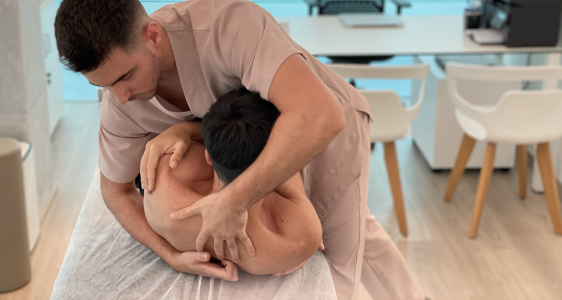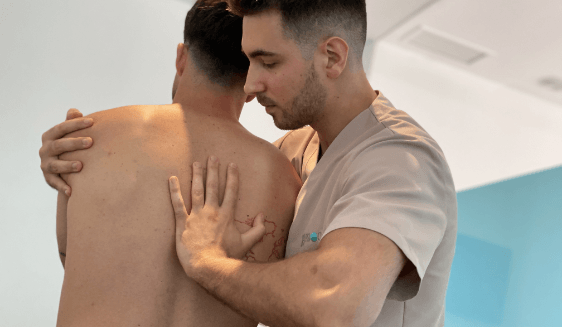
La osteopatía se centra en buscar las hipomovilidades en el cuerpo
La Osteopatía es la ciencia que con el conocimiento de la anatomía, fisiología y biomecánica lleva a desarrollar un método holístico basado en tratar al paciente y no la patología, además de no solo erradicar la sintomatología, sino de hallar el motivo que la ocasiona e intentar eliminarlo. Así, la osteopatía se centra en buscar las hipomovilidades en el cuerpo, es decir, las disfunciones articulares o zonas del cuerpo que no se están moviendo como deberían porque existe alguna limitación o bloqueo articular.
En definitiva, hablamos de técnicas manuales que van más allá de curar un simple dolor: buscan que el paciente recupere el equilibrio orgánico.
¿Cuándo se origina la osteopatía?
La osteopatía se origina a finales del siglo XIX, en los Estados Unidos, por un el médico y cirujano llamado Andrew Taylor Still. Él comenzó a evidenciar las relaciones entre el sistema músculo-esquelético y los otros sistemas orgánicos; así, entre los años 1870 y 1874 Still comenzaba con experiencias osteopáticas clínicas. En junio de 1874, se creaba oficialmente la Osteopatía como disciplina médica.

1. Osteopatía estructural: se emplean técnicas dirigidas a estructuras anatómicas como el músculo, articulación, ligamentos usando manipulaciones de alta velocidad y baja amplitud; técnicas funcionales o miofasciales; técnicas de bombeo; técnicas articulatorias e.t.c
2. Osteopatia visceral: se emplean técnicas dirigidas a la fascia y ligamentos que dan soporte y sujeción a los órganos del cuerpo. Dos buenos ejemplos de patología visceral que se pueden tratar con osteopatía es la hernia de hiato y el estreñimiento.
3. Osteopatia craneal: se emplean técnicas dirigidas a las suturas craneales (articulaciones en el cráneo) y a las membranas intraoseas. Consiste en devolver movilidad/plasticidad al cráneo y al sacro para así restaurar el ritmo respiratorio cráneo-sacro. El cráneo y el sacro están íntimamente relacionados a través de la duramadre (capa meningea más externa) por lo que tensiones en esta membrana pueden alterar el ritmo cráneo-sacro y dar problemas en el resto del organismo.

INDICACIONES
- Dolores vertebrales: cervical, dorsal, lumbar
- Dolores o síntomas manifestándose a nivel de cabeza o del rostro: dolores de cabeza y migrañas, dolores de ojos, vértigos, neuralgias faciales, etc.
- Dolores de los miembros superiores: hombro, codo, antebrazo o la mano, neuralgias cervicobraquiales.
- Dolores torácicos, abdominales o pélvicos
- Dolores de los miembros inferiores: cadera, rodilla, tobillo o el pie: ciáticas, cruralgias, tendinitis, esguinces.
Preguntas frecuentes - Osteopatía
¿Qué es la osteopatía?
La osteopatía es una terapia manual que se centra en el diagnóstico y tratamiento de disfunciones del sistema musculoesquelético. Se basa en la premisa de que el cuerpo tiene la capacidad de autorregenerarse y que, mediante técnicas manuales, se puede restaurar el equilibrio y la función adecuada de los tejidos y órganos.
¿Qué afecciones trata la osteopatía?
La osteopatía aborda una amplia gama de afecciones, incluyendo:
- Dolores de espalda y cuello.
- Lesiones deportivas.
- Dolores de cabeza y migrañas.
- Problemas articulares.
- Trastornos digestivos.
- Alteraciones posturales.
Al tratar el cuerpo de manera integral, la osteopatía busca identificar y corregir las causas subyacentes de estas afecciones.
¿En qué se diferencia la osteopatía de la fisioterapia?
Aunque ambas disciplinas comparten objetivos similares, la osteopatía se centra en un enfoque holístico del cuerpo, utilizando principalmente técnicas manuales para restaurar el equilibrio y la función. Por otro lado, la fisioterapia se enfoca más en tratar síntomas específicos mediante ejercicios terapéuticos, electroterapia y otras modalidades, con un énfasis en la rehabilitación física y la recuperación funcional.
¿Es segura la osteopatía?
Sí, la osteopatía es considerada segura cuando es realizada por un profesional cualificado. En Fisioclínica La Herradura, contamos con años de experiencia y una formación continua en el sector, garantizando tratamientos seguros y efectivos para nuestros pacientes.
¿Cuántas sesiones de osteopatía son necesarias?
El número de sesiones varía según la afección y la respuesta individual de cada paciente. En la primera visita, se realiza una evaluación completa para determinar el plan de tratamiento adecuado. Algunas afecciones pueden requerir una sola sesión, mientras que otras pueden necesitar varias para lograr resultados óptimos.
¿La osteopatía es adecuada para niños?
Sí, la osteopatía puede ser beneficiosa para niños de todas las edades. Se adapta a las necesidades individuales del niño y puede ayudar en condiciones como problemas de lactancia, cólicos, tortícolis, trastornos digestivos y lesiones deportivas, entre otros.
¿Qué siento después de una sesión de osteopatía?
Después de una sesión, es posible experimentar una sensación de cansancio, dolor de cabeza o molestias temporales en las áreas tratadas. Estos síntomas suelen ser parte del proceso de autocuración del cuerpo y desaparecen en poco tiempo. Es recomendable descansar y evitar actividades físicas intensas tras la sesión.
